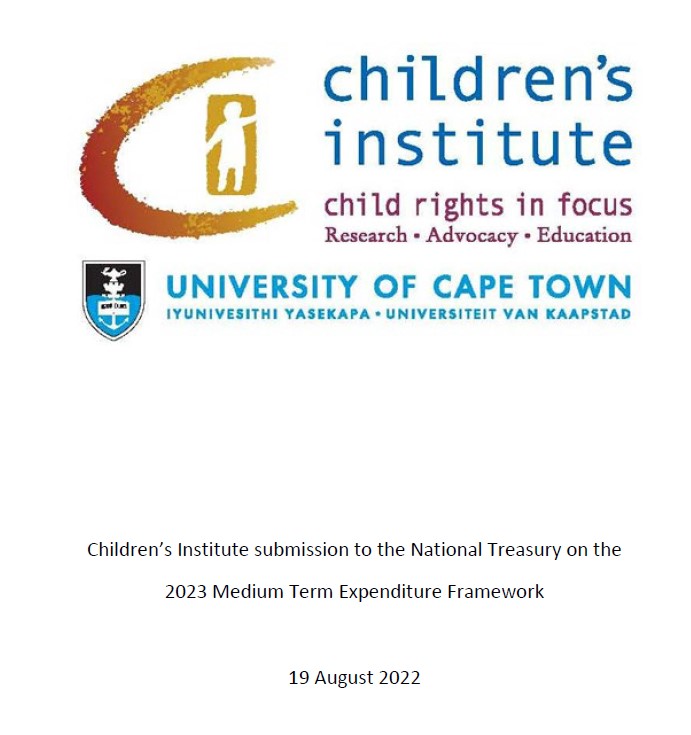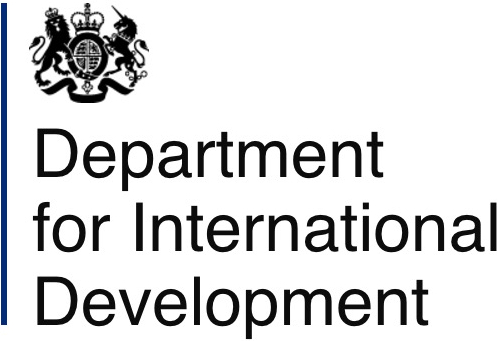Definition
Children are defined as living in over-crowded dwellings when there is a ratio of more than two people per room (excluding bathrooms but including kitchen and living room). The over-crowding ratio is obtained by dividing the total number of household members by the total number of rooms occupied by the household. Thus, a dwelling with two bedrooms, a kitchen and sitting-room would be defined as over-crowded if there were more than eight people living in it.Data
Source
Statistics South Africa (2003 - 2025) General Household Survey 2002 - 2024. Pretoria, Cape Town: Statistics South Africa.
Analysis by Katharine Hall & Sumaiyah Hendricks, Children’s Institute, University of Cape Town.
Analysis by Katharine Hall & Sumaiyah Hendricks, Children’s Institute, University of Cape Town.
Notes
- Children are defined as persons aged 0 – 17 years.
- Population numbers have been rounded off to the nearest thousand.
- Sample surveys are always subject to error, and the proportions simply reflect the mid-point of a possible range. The confidence intervals (CIs) indicate the reliability of the estimate at the 95% level. This means that, if independent samples were repeatedly taken from the same population, we would expect the proportion to lie between upper and lower bounds of the CI 95% of the time. The wider the CI, the more uncertain the proportion. Where CIs overlap for different sub-populations or time periods we cannot be sure that there is a real difference in the proportion, even if the mid-points differ. CIs are represented in the bar graphs by vertical lines at the top of each bar.
What do the numbers tell us?
The UN Committee on Economic, Social and Cultural Rights defines ‘habitability’ as one of the criteria for adequate housing.[1] Overcrowding is a problem because it can undermine children’s needs and rights. For instance, it is difficult for school children to do homework if other household members want to sleep or watch television. Children’s right to privacy can be infringed if they do not have space to wash or change in private. The right to health can be infringed as communicable diseases spread more easily in overcrowded conditions, and young children are particularly susceptible to the spread of disease. Overcrowding also places children at greater risk of sexual abuse, especially where boys and girls have to share beds, or children have to share beds with adults.
Overcrowding makes it difficult to target services and programmes to households effectively – for instance, urban households are entitled to six kilolitres of free water, but this household-level allocation discriminates against overcrowded households because it does not take account of household size.
In 2024, 3.7 million children lived in overcrowded households. This represents 17% of the child population – much higher than the share of adults living in crowded conditions (10%).
Overcrowding is associated with housing type: 42% of children who stay in informal dwellings also live in overcrowded conditions, compared with 24% of children in traditional dwellings and 15% of children in formal housing.
Young children are slightly more likely than older children to live in overcrowded conditions. Twenty-one percent of children younger than six years live in crowded households, compared to 15% of children over 12 years old.
There is a strong racial bias in children’s housing conditions. While 18% of African and 22% of Coloured children live in crowded conditions, only around 1% of White children are recorded as living in overcrowded households. Children in the poorest 20% of households are more likely to be living in overcrowded conditions (23%) than children in the richest 20% of households (2%).
The average household size has decreased from 4.5 at the time of the 1996 population census, to around 3.2 in 2024.[2] The reduction in average household size during the 1990s and early 2000s was linked to the rapid provision of small subsidy houses that could not accommodate extended families.[3, 4] It has also been linked to adult urban migration coupled with continuing constraints on family co-migration and declining marriage and cohabitation rates between men and women.[5] In more recent years, an important contributor to declining average household size has been the fairly rapid growth in single-person households where adults live alone.[6-8] The 2022 Census counted 18 million households in South Africa, double the number recorded in 1996. 2 The weighted count of households in the 2024 General Household Survey was nearly 20 million. Of these nearly 20 million households 27% (around 5.3 million) were households where one person lived alone.[9, 10] Households in which children live are larger than the national average, although they have also declined in size over time. The mean household size for adult-only households in 2024 was 1.7 while the mean household size for households that included children was 4.7.
Overcrowding makes it difficult to target services and programmes to households effectively – for instance, urban households are entitled to six kilolitres of free water, but this household-level allocation discriminates against overcrowded households because it does not take account of household size.
In 2024, 3.7 million children lived in overcrowded households. This represents 17% of the child population – much higher than the share of adults living in crowded conditions (10%).
Overcrowding is associated with housing type: 42% of children who stay in informal dwellings also live in overcrowded conditions, compared with 24% of children in traditional dwellings and 15% of children in formal housing.
Young children are slightly more likely than older children to live in overcrowded conditions. Twenty-one percent of children younger than six years live in crowded households, compared to 15% of children over 12 years old.
There is a strong racial bias in children’s housing conditions. While 18% of African and 22% of Coloured children live in crowded conditions, only around 1% of White children are recorded as living in overcrowded households. Children in the poorest 20% of households are more likely to be living in overcrowded conditions (23%) than children in the richest 20% of households (2%).
The average household size has decreased from 4.5 at the time of the 1996 population census, to around 3.2 in 2024.[2] The reduction in average household size during the 1990s and early 2000s was linked to the rapid provision of small subsidy houses that could not accommodate extended families.[3, 4] It has also been linked to adult urban migration coupled with continuing constraints on family co-migration and declining marriage and cohabitation rates between men and women.[5] In more recent years, an important contributor to declining average household size has been the fairly rapid growth in single-person households where adults live alone.[6-8] The 2022 Census counted 18 million households in South Africa, double the number recorded in 1996. 2 The weighted count of households in the 2024 General Household Survey was nearly 20 million. Of these nearly 20 million households 27% (around 5.3 million) were households where one person lived alone.[9, 10] Households in which children live are larger than the national average, although they have also declined in size over time. The mean household size for adult-only households in 2024 was 1.7 while the mean household size for households that included children was 4.7.
[1] Office of the United Nations High Commissioner for Human Rights. The Right to Adequate Housing (art. 11 (1)): 13/12/91. Geneva: United Nations. 1991.
[2] Statistics South Africa. Census 2022: Statistical release P0301.4. Pretoria: Stats SA; 2023. Analysis by K Hall, Children's Institute, University of Cape Town. 2023.
[3] Hall K. Accommodating the poor? A review of the housing subsidy scheme and its implications for children. In: Leatt A, Rosa S, editors. Towards a Means to Live: Targeted poverty alleviation to make children's rights real. Cape Town: Children's Institute, University of Cape Town. 2005.
[4] Public Service Commission. Report on the Evaluation of the National Housing Subsidy Scheme. Pretoria: Public Service Commission. 2003.
[5] Posel D, Hall K. The economics of households in South Africa. In: Oqubay A, Tregenna F, Valodia I, editors. Oxford Handbook of the South African Economy. Oxford: Oxford University Press. 2021.
[6] Hall K, Mokomane Z. The shape of children's families and households. In: Hall K, Richter L, Mokomane Z, Lake L, editors. Children, Families and the State: Collaboration and contestation South African Child Gauge 2018. Cape Town: Children's Institute, University of Cape Town. 2018.
[7] Thornton A. Household Formation, Living Alone, and Not Getting Married in South Africa. SALDRU Working Paper Number 295. Cape Town: Southern Africa Labour and Development Research Unit, University of Cape Town. 2023.
[8] Mutanda N, Omidegwu C. Solitary living in South Africa: What is driving the pattern and change? Journal of Population Research. 2019, 36(2):137-158.
[9] Statistics South Africa. General Household Survey 2024. Pretoria: Stats SA; 2025. Analysis by K Hall, Children's Institute, University of Cape Town.
Technical notes
There is no standard measure of overcrowding in South Africa, but there are many international definitions. The definition used here is derived from the UN-HABITAT definition, which is a maximum of two people per habitable room. ‘Habitable’ rooms exclude bathrooms and toilets. The data are taken from the General Household Survey, which records the total number of people in a household as well as the total number of rooms occupied (excluding bathrooms and toilets).
This indicator is based on the ratio of total household size to the total number of rooms occupied, excluding bathrooms. However in 2020 the questions about different room types was dropped, and instead a one-shot question was used, which asked how many rooms in total the household occupied.This was because the questionnaire was shortened to allow for a shorter telephonic interview during lockdown. For purposes of this indicator in 2020, the total number of rooms is estimated as the reported total less one if the household occupies more than one room in total and has a toilet/bathroom inside the dwelling.
This indicator is based on the ratio of total household size to the total number of rooms occupied, excluding bathrooms. However in 2020 the questions about different room types was dropped, and instead a one-shot question was used, which asked how many rooms in total the household occupied.This was because the questionnaire was shortened to allow for a shorter telephonic interview during lockdown. For purposes of this indicator in 2020, the total number of rooms is estimated as the reported total less one if the household occupies more than one room in total and has a toilet/bathroom inside the dwelling.
For purposes of measuring and monitoring persistent racial inequality, population groups are defined as 'African', 'Coloured', 'Indian', and 'White'.
Strengths and limitations of the data
The numbers are derived from the General Household Survey, a multi-purpose annual survey conducted by the national statistical agency, Statistics South Africa, to collect information on a range of topics from households in the country’s nine provinces.
The GHS uses a Master Sample frame which has been developed as a general-purpose household survey frame that can be used by all other Stats SA household-based surveys that have design requirements that are reasonably compatible with the GHS. The sample is drawn from Census enumeration areas using a stratified two-stage design with probability proportional to size sampling of PSUs in teh first stage, and sampling of dwelling units with systematic sampling in the second stage. The resulting sample consists of just over 20,000 households with around 70,000 individuals, and should be representative of all households in South Africa. It is also designed to be representative at provincial level and within provinces at metro/non-metro levels and three geography types (urban areas, rural areas under traditional authority, and farms).
The sample consists of households and does not cover other collective institutionalised living-quarters such as boarding schools, orphanages, students’ hostels, old-age homes, hospitals, prisons, military barracks and workers’ hostels. These exclusions probably do not have a noticeable impact on the findings in respect of children.
Changes in sample frame and stratification
Since 2014 the GHS has been based on the 2013 master sample that that is, in turn, based on information collected during the 2011 Population Census. The previous master sample for the GHS was used for the first time in 2008, and the one before that in 2004. These again differed from the master sample used in the first two years of the GHS: 2002 and 2003. Thus there have been four different sampling frames during history of the annual GHS, with the changes occurring in 2004, 2008 and 2013. In addition, there have been changes in the method of stratification over the years. These changes could compromise comparability across iterations of the survey to some extent, although it is common practice to use the GHS for longitudinal monitoring and many of the official trend analyses are drawn from this survey.
Weights
Person and household weights are provided by Stats SA and are applied in Children Count analyses to give population estimates on the indicators. The GHS weights are derived from Stats SA’s mid-year population estimates for the relevant year. The population estimates are based on a model that is revised from time to time when it is possible to calibrate the population model to Census data and larger population surveys such as the Community Survey.
In 2017, Stats SA revised its demographic model to produce a new series of mid-year population estimates and the GHS data were re-released with the revised population weights. All the Children Count indicators were re-analysed retrospectively, using the revised weights provided by Stats SA, based on the 2013 model. The estimates are therefore comparable over all years. The revised weights particularly affected estimates for the years 2002 – 2007.
The 2017 model drew on the 2011 census, along with vital registration, antenatal and other administrative data, but was a “smoothed” model that did not mimic the unusual shape of the age distribution found in the census. The results of the 2011 census were initially distrusted because it seemed to over-count children in the 0 – 4 age group and under-count children in the 4 – 14-year group. It is now thought that the fertility rates recorded in the 2011 population census may have been an accurate reflection of demopraphic trends, with an unexplained upswing in fertility around 2009 after which fertility rates declined again gradually. Similar patterns were found in the vital registration data as more births were reported retrospectively to the Department of Home Affairs, and in administrative data from schools, compiled by the Department of Basic Education. In effect, this means that there may be more children in South Africa than appear from the analyses presented in these analyses, where we have applied weights based on a model that it is now known to be inaccurate.
Stats SA has subsequently developed a new population model - the 2022 series, which provides revised mid-year population estimates back to 2002 and projected to 2032. However, the GHS series has not yet been reweighted.The population estimates in Children Count are therefore based on weights derived from outdated population model (2017). It is not yet clear when and how the population model will be revised again following the 2022 Census, as there are concerns around census under-count and plausibility of its findings.
Disaggregation
Statistics South Africa suggests caution when attempting to interpret data generated at low level disaggregation. The population estimates are benchmarked at the national level in terms of age, sex and population group while at provincial level, benchmarking is by population group only. This could mean that estimates derived from any further disaggregation of the provincial data below the population group may not be robust enough.
Reporting error
Error may be present due to the methodology used, i.e. the questionnaire is administered to only one respondent in the household who is expected to provide information about all other members of the household. Not all respondents will have accurate information about all children in the household. In instances where the respondent did not or could not provide an answer, this was recorded as “unspecified” (no response) or “don’t know” (the respondent stated that they didn’t know the answer).
For more information on the methods of the General Household Survey, see the metadata for the respective survey years, available on Nesstar http://interactive.statssa.gov.za:8282/webview/ or DataFirst www.datafirst.uct.ac.za
The GHS uses a Master Sample frame which has been developed as a general-purpose household survey frame that can be used by all other Stats SA household-based surveys that have design requirements that are reasonably compatible with the GHS. The sample is drawn from Census enumeration areas using a stratified two-stage design with probability proportional to size sampling of PSUs in teh first stage, and sampling of dwelling units with systematic sampling in the second stage. The resulting sample consists of just over 20,000 households with around 70,000 individuals, and should be representative of all households in South Africa. It is also designed to be representative at provincial level and within provinces at metro/non-metro levels and three geography types (urban areas, rural areas under traditional authority, and farms).
The sample consists of households and does not cover other collective institutionalised living-quarters such as boarding schools, orphanages, students’ hostels, old-age homes, hospitals, prisons, military barracks and workers’ hostels. These exclusions probably do not have a noticeable impact on the findings in respect of children.
Changes in sample frame and stratification
Since 2014 the GHS has been based on the 2013 master sample that that is, in turn, based on information collected during the 2011 Population Census. The previous master sample for the GHS was used for the first time in 2008, and the one before that in 2004. These again differed from the master sample used in the first two years of the GHS: 2002 and 2003. Thus there have been four different sampling frames during history of the annual GHS, with the changes occurring in 2004, 2008 and 2013. In addition, there have been changes in the method of stratification over the years. These changes could compromise comparability across iterations of the survey to some extent, although it is common practice to use the GHS for longitudinal monitoring and many of the official trend analyses are drawn from this survey.
Weights
Person and household weights are provided by Stats SA and are applied in Children Count analyses to give population estimates on the indicators. The GHS weights are derived from Stats SA’s mid-year population estimates for the relevant year. The population estimates are based on a model that is revised from time to time when it is possible to calibrate the population model to Census data and larger population surveys such as the Community Survey.
In 2017, Stats SA revised its demographic model to produce a new series of mid-year population estimates and the GHS data were re-released with the revised population weights. All the Children Count indicators were re-analysed retrospectively, using the revised weights provided by Stats SA, based on the 2013 model. The estimates are therefore comparable over all years. The revised weights particularly affected estimates for the years 2002 – 2007.
The 2017 model drew on the 2011 census, along with vital registration, antenatal and other administrative data, but was a “smoothed” model that did not mimic the unusual shape of the age distribution found in the census. The results of the 2011 census were initially distrusted because it seemed to over-count children in the 0 – 4 age group and under-count children in the 4 – 14-year group. It is now thought that the fertility rates recorded in the 2011 population census may have been an accurate reflection of demopraphic trends, with an unexplained upswing in fertility around 2009 after which fertility rates declined again gradually. Similar patterns were found in the vital registration data as more births were reported retrospectively to the Department of Home Affairs, and in administrative data from schools, compiled by the Department of Basic Education. In effect, this means that there may be more children in South Africa than appear from the analyses presented in these analyses, where we have applied weights based on a model that it is now known to be inaccurate.
Stats SA has subsequently developed a new population model - the 2022 series, which provides revised mid-year population estimates back to 2002 and projected to 2032. However, the GHS series has not yet been reweighted.The population estimates in Children Count are therefore based on weights derived from outdated population model (2017). It is not yet clear when and how the population model will be revised again following the 2022 Census, as there are concerns around census under-count and plausibility of its findings.
Disaggregation
Statistics South Africa suggests caution when attempting to interpret data generated at low level disaggregation. The population estimates are benchmarked at the national level in terms of age, sex and population group while at provincial level, benchmarking is by population group only. This could mean that estimates derived from any further disaggregation of the provincial data below the population group may not be robust enough.
Reporting error
Error may be present due to the methodology used, i.e. the questionnaire is administered to only one respondent in the household who is expected to provide information about all other members of the household. Not all respondents will have accurate information about all children in the household. In instances where the respondent did not or could not provide an answer, this was recorded as “unspecified” (no response) or “don’t know” (the respondent stated that they didn’t know the answer).
For more information on the methods of the General Household Survey, see the metadata for the respective survey years, available on Nesstar http://interactive.statssa.gov.za:8282/webview/ or DataFirst www.datafirst.uct.ac.za

 The SAECR 2024 tracks trends on the status of children under 6.
The SAECR 2024 tracks trends on the status of children under 6. 











